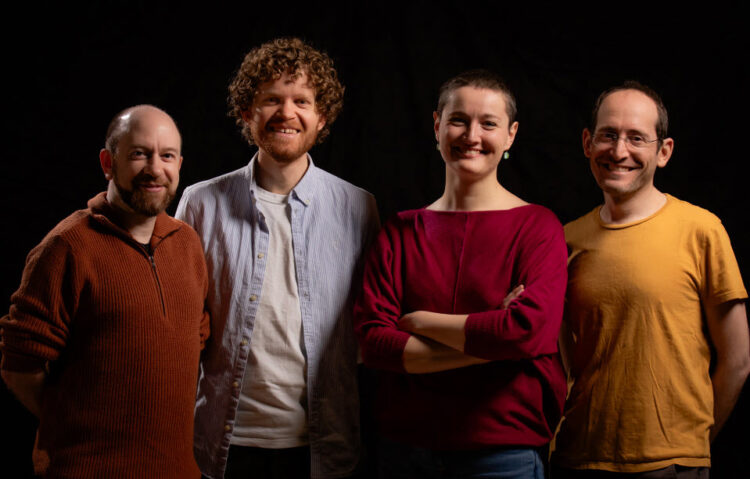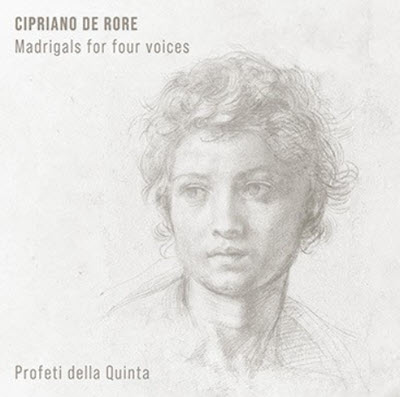by Karen M. Cook
Published June 23, 2024
Cipriano de Rore: Primo libro de madrigali a quattro voci (1550) Profeti Della Quinta, directed by Elam Rotem. Available on major streaming services or as an MP3 download.

Over the last 15 years, the ensemble Profeti della Quinta has recorded an astounding 13 albums, appeared in a documentary film, won a major early-music competition, and gone on international tour. Founder Elam Rotem has also made a household name for himself for his popular YouTube series Early Music Sources. Rather than take a well-earned break, though, they have emerged with yet another new album.

In most of their work, the ensemble focuses on repertory that could be considered lesser known, in some shape or form. At first glance, this album does not appear to fit that mold — Cipriano de Rore is hardly “lesser known.” As Rotem writes in the liner notes, the Flemish-born Rore (c.1515-1565) was “known as an innovator in the field of the Italian madrigal: famously, Cesare Monteverdi explained in 1607 that the groundbreaking music of his brother Claudio was simply a continuation of the path paved by the ‘divine’ Cipriano de Rore.”
But, Rotem explains, Rore often gets lumped in with some of the more experimental, expressive composers of the later 16th century. This album, however, explores Rore’s first book of madrigals, which does tend to get overlooked since it is decidedly less crunchy and more in line with what earlier innovators in the genre were doing.
In its own time, these madrigals were quite popular, reprinted numerous times, used as a pedagogical tool for teaching counterpoint, published in instrumental format, and turned into diminutions. Despite this popularity, though, none of the works on this album have ever been recorded in their original four-voice setting.
Seven madrigals form the core of this album. Six of them are performed both by voices and by solo harpsichord, reflecting the ways in which de Rore’s works were used after the first book’s publication. Only one madrigal, “Se’l mio sempre per voi donna languire,” is only performed by voices, and the album concludes with a French two-part chanson originally written for the wedding of Princess Anna d’Este in 1548.
A short album — this one totals just 38:08 — is a nice change of pace. The length invites the listener to play it again immediately. In doing so, one picks up on all sorts of things: the ways in which the instrumental versions play with the original vocal setting, the vocalists’ little expressive ornamental gestures, yet another beautifully unified phrase. Profeti della Quinta’s blend is lovely, their approach intimate and welcoming; it feels almost casual, such is the comfort level that they have with this repertory, but with professional polish. It’s like a glass of good wine and a conversation with a good friend; sometimes animated, sometimes mellow, sometimes content to sit in silence.
If there’s one thing I could critique, it’s that this comfort makes the group sound a bit less despairing than some of the texts warrant. There isn’t as much of a shift in emotional impact from the grief in “Com’havran fin le dolorose temper” to the bitterness in “Io credea che’l morire” to the loving adoration in “La bella netta ignuda e bianca mano,” for example. There is, however, a nice punch to “Quel foco che tanti anni,” and the anger and resentment in “Se’l mio sempre …” builds palpably throughout the work.
And the concluding “En vos adieux” provides a marked change in language, style, and sentiment — a beautifully sweet end to the album. Overall, it’s fine work, and I hope they might in the future choose to record more of this material.
Karen M. Cook is Associate Professor of Music History at the University of Hartford. She specializes in late medieval music theory and notation, focusing on developments in rhythmic duration. She also maintains a primary interest in musical medievalism in contemporary media, particularly in video games. For EMA, she recently reviewed ensemble Egeria, singing and improvising music from 12-th-c. Sicily.




